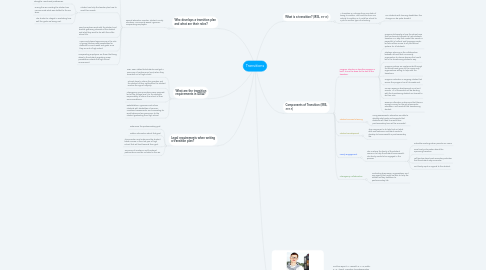
1. Who develops a transition plan and what are their roles?
1.1. Special Education Teacher, Student, Family members, Community Based Agencies, Cooperating Employers
1.1.1. The Special Education Teacher guides the student and writes the IEP based on what the student's goals are for postsecondary life.
1.1.2. Student can help the teacher plan how to meet their needs.
1.1.2.1. The student can help draft parts of the IEP when it comes to student interests, strengths, needs and preferences.
1.1.2.2. During the IEP meeting the student can communicate what was drafted to the IEP team.
1.1.2.3. The student is integral in evaluating how well the goals are being met.
1.1.3. Family members work with the student and teacher gathering interests of the student and what they want to do with their after school life.
1.1.4. Community based agencies are in the role of giving locations and possibilities for students to meet needs and goals once they are out of high school
1.1.5. Cooperating employers are those that bring ideas to the student regarding career possibilities outside the high school environment.
2. What are the transition requirements in IDEA?
2.1. IDEA 2004 states that students must get a Summary of Performance (SOP) when they transition out of high school.
2.2. Schools have to inform the guardian and the student of their rights when the student reaches the age of majority.
2.3. Interagency communications were required, but at the college level it is the student's responsibility to inform the school of their accommodations.
2.4. Rehabilitation Agencies must inform students with disabilities of services, vocational assessments, and counseling for work behaviors two years prior to the student graduating from high school.
3. Legal requirements when writing a transition plan?
3.1. Determine the postsecondary goal.
3.2. Gather information about that goal.
3.3. The provider must make sure the student takes courses in their last year of high school that will lead towards their goal.
3.4. Summary of academic and functional performance must be included in the IEP.
4. What is a transition? (IRIS, 2013)
4.1. A transition is a change from one state of being to another. This could be from one activity to another or it could be school to a job or another type of schooling.
4.1.1. For students with learning disabilities, this change can be quite stressful
5. Components of Transition (IRIS, 2013)
5.1. Program Structure is how the program is built. This is the base for the rest of the transition.
5.1.1. Program philosophy is how the schools use their community outreach to help students transition in a way that meets their needs, is respectful of cultural and language needs, but also offers access to all post-school options for all students
5.1.2. Strategic planning is the collaboration between schools and community organization to discuss barriers that could be in the transitioning student's way.
5.1.3. Program policies are implemented through the schools and given to the community organizations willing to help with the transitions.
5.1.4. Program evaluation is ongoing studies that ensure the program has all its needs met.
5.1.5. Human resource development is just as it sounds. All of those who will be working with the transitioning student are trained to do their role.
5.1.6. Resource allocation makes sure that there is enough money for the job placements, education, and needs of the transitioning student.
5.2. Student Focused Planning
5.2.1. Using assessments, educators are able to identify what goals and supports that students will need to ensure their post-secondary time will be successful.
5.3. Student Development
5.3.1. This component is to help find out what skills and behaviors a student needs to develop to be successful in post-secondary life.
5.4. Family Engagement
5.4.1. This is where the family of the student comes in to help the student be successful. The family needs to be engaged in the process.
5.4.1.1. Schedule meetings when parents can come
5.4.1.2. Give family information about the upcoming transition.
5.4.1.3. Tell families about post-secondary activities that the student may encounter.
5.4.1.4. Get family input in regards to the student.
5.5. Interagency Collaboration
5.5.1. Contacting businesses, organizations, and any agency that might be able to help the student as they transition to post-secondary life.
